- Now that it’s over, what are my first thoughts about this overall project? Are they mostly positive or negative? My first thoughts about this project is that overall I think that I did well, although I know there are areas for improvement.
- If positive, what comes to mind specifically? Negative? I think that some things I did well were my presentation of my ideas and my case study and comparison. I think I could’ve analysed and evaluated my own final images in more detail.
- What were some of the most interesting discoveries I made while working on this project? I discovered that I prefer and find it easier to have a physical final piece that I can hold rather than an image on my blog.
- What were the challenges? I think that the thing I found most challenging was my time management, and also making sure that I had everything completed to the best of my ability.
- How did I come up with my final best solution? I took inspiration from a range of different photographers, but I also used my own imagination to experiment with different ideas.
- What most got in the way of my progress if anything? I think that my time management was the biggest thing that got in the way of me making a lot of progress.
- What obstacles did I overcome? I was struggling to come up with ideas for my final pieces, but once I had taken a break and thought about the type of message and feeling I wanted to present, I was fine.
- What did I learn were my greatest strengths? My biggest areas for improvement? I think that my greatest strength was that I was able to produce two final pieces that I was proud of, despite changing my mind a lot. I think my biggest area for improvement is my time management skills, and putting as much detail as possible into my blog posts.
- What would I do differently if I were to approach the same problem again? I would try to be as prepared as possible by making a checklist of everything I needed to produce and include in my blog posts, and tick them off as I went along. I would also try to make sure I had got enough done beforehand as possible, as it would put less strain on me during the controlled conditions.
- How will I use what I have learned in the future? I will use what I have learned in the future by ensuring I know what is expected of me to produce, and make sure that I put as much effort in as possible.
Self-Reflection Controlled Conditions
Now that it’s over, what are my first thoughts about this overall project? Are they mostly positive or negative?
Now that its over, my first thoughts are that it went really well, and i was mostly consistent throughout all of my blog posts.
If positive, what comes to mind specifically? Negative?
I think that my final images were really strong, and linked back to the photographer I researched and referenced.
What were some of the most interesting discoveries I made while working on this project?
I discovered that i’m good at explaining the process and showing it in steps. I also found out that there were more steps involved then I intentionally thought, for example the work I did in the style of Evilsabeth Schmitz-Garcia, that involved printing out and taking photos of the scans.
What were the challenges?
Time was a big challenge, as I finished with 4 final images, I felt that the time spent to edit them, and explain them, as well as presenting it, took longer than i thought.
What can I improve?
I could of shown more ways of my exploration of ideas, as it was my weakest point. I did think about by didn’t write much about how, and why I chose to do what I did, which is a big part about the process and presentation, as it leads on to how i edited the final image.
How will I use what I have learned in the future?
I have a better understanding of what I can improve and what I need to go into detail about more. I also feel that my Photoshop skills are more consistent.
Identity and Place – self reflection
- Now that it’s over, what are my first thoughts about this overall project? Are they mostly positive or negative? My initial thoughts after the controlled conditions exam are both positive and negative.
- If positive, what comes to mind specifically? Negative? In terms of positive, I think my written work was good quality as I spent most of my time on those pieces, however I think my actual photographs could have been better.
- What were some of the most interesting discoveries I made while working on this project? I enjoyed learning about Francesca Woodman as she died at the early age of 22 so I think her life story was very interesting.
- What were the challenges? I think the hardest part of the project was capturing the photos themselves, as we had a timed limit and COVID made it difficult to take images of people.
- What is the most important thing I learned personally? I’ve learnt that I need to take my images earlier in case I don’t like the outcome and need to take them again. I also need to plan my final plan for my images in advanced.
- How did I come up with my final best solution? I decided to use Woodman’s simple method of long exposure and black and white for her study and I edited my images inspired by Carolle Benitah on photoshop rather than physically.
- What most got in the way of my progress if anything? COVID got in the way of my progress as the bus times were limited so travel was difficult and there was a lack of people I could take photographs of. Also the time limit made the project difficult.
- What obstacles did I overcome? I managed to finish my project within the 5 hour time limit.
- What did I learn were my greatest strengths? My biggest areas for improvement? I think my strengths are my written work and detailed analysis and my weakness was my photographs and editing.
- What would I do differently if I were to approach the same problem again? I would explore more ideas for my final photographs and prepare more in advanced with taking the photos.
- What could I do differently from a personal standpoint the next time I work? Manage my time better in the 2 weeks leading to the exam and become more motivated to go above my expectations.
- What can I improve? Taking physical photographs and exploring ideas.
- How will I use what I have learned in the future? I will plan my photoshoots in the weeks leading to the exam and practice photoshop techniques.
Self-Reflection Blog Post
Now that it’s over, what are my first thoughts about this overall project? Are they mostly positive or negative?
I found the photographers interesting and the topic interesting, however I do not like my blog posts much and feel that they turned out different to what I expected.
What were some of the most interesting discoveries I made while working on this project?
I found Rania Matar’s A Girl and Her Room interesting, how she compares the American life to the Middle East.
What were the challenges?
My Alec Soth photo shoot was difficult to organise because I needed to organise it along side my dad as he drove me to Corbiere.
What most got in the way of my progress if anything?
My organisation because I left everything to a few days before the exam.
What did I learn were my greatest strengths?
Greatest strength was when in the exam conditions I worked well with the time I had.
What would I do differently if I were to approach the same problem again?
I would make sure to prepare more before the exam and give myself less work so that I had time to do extra things or try to improve the quality of my work further and go into things with more detail.
What can I improve?
I could have done a third photo shoot with the photographer i looked at where I was planning to do a collage with new and old photos to make my final outcomes more interesting.
How will I use what I have learned in the future?
I will get more organised earlier before the exam.
Set yourself some targets for moving your photography forward. These could be skills based, analytical understanding, written analysis, organisation, blog post structure.
I would take more photos and act on all the things I said I was going to do.
SELF-REFLECTION BLOG POST
Now that it’s over, what are my first thoughts about this overall project? Are they mostly positive or negative?
My first thoughts about this project are that I feel as if I should have thought more in depth about what the assessment was asking me to photograph rather than going off on my own idea which might not link very well to what is asked of me.
If positive, what comes to mind specifically? Negative?
My positive views about this project are that i enjoyed the topic of identity and place. It seemed as if the whole identity theme was not too hard to understand and easy to find something to work on.
What were some of the most interesting discoveries I made while working on this project?
During this project I found out how to use different light to effect different parts of photos that I was taking. For example, to get a glow effect on a front of a face, use mostly a white light , and then use coloured light in the background.
What were the challenges?
I found it tricky to find an artist that related to my work and my final outcomes. The artist in the end that I chose was good enough to relate to but wasn’t very helpful when coming to analysis and comparing my work and theirs.
What is the most important thing I learned personally?
The most important thing I have learned during this project is that I definitely need to get more work done before the exam as I was very close of running out of time.
How did I come up with my final best solution?
My final solution to this project was to use inspirations from other photographers and input that into my work, then i would confidently know that my work has some sort of connection to the topic.
What most got in the way of my progress if anything?
The time that I had I felt as if I wasn’t going to have enough time, therefore I worried and struggled to focus on what needed to be done with the time that I did have.
What obstacles did I overcome?
In the end I didn’t doubt myself that my work was that bad, so i overcame my fear of thinking that my work was rubbish when actually it came out okay.
What did I learn were my greatest strengths? My biggest areas for improvement?
My greatest strengths that I found was analysing a photographers piece of work and working in the studio. In the studio I used equipment that I hadn’t really used often and my images turned out good. I improved on my editing skills in photoshop and how to recover an image that had not gone to plan with wording and comparing it to a certain photographers work.
What would I do differently if I were to approach the same problem again?
If I came across some images that I was not happy with in the exam, I would make sure that I had enough other images to use and another plan if needed.
What could I do differently from a personal standpoint the next time I work?
I would make sure that if I would have the exam again or a similar one, I would check my images first before choosing my best ones in the exam.
What can I improve?
I can improve on my knowledge of how to evaluate my own images and how to link them back to the question asked or the topic or a photographer. I would write more in detailed of what my point is for my work and explain exactly what i am trying to get across to people in my images.
How will I use what I have learned in the future?
Hopefully in my next exam i can improve by getting a better grade than I did before by using my free time to make the exam be easier for me and for me not to stress. I can also think more about what is being asked and be more creative with my final outcomes.
WWW – WHAT WENT WELL
In my opinion , my (what went well) would be my research and analysis and understanding of the topic. This is shown as I got I better grade in that part of the exam then the other parts. My own understanding for the work I can write in detail and I can add in other views of the topic from different people.
What are your strengths and weaknesses?
As said before I feel as if my strengths in this project were the analysis with both a photographers work and my own.
My weakness in this project would defiantly be the skill level of using photoshop.
EBI – EVEN BETTER IF
I feel I could improve my work if I came up with a more creative and advanced outcome with my final images. This could be either how i present them on the blog, or how and when and where I take them. I could change my idea on the topic and think of something more interesting that I would have more to write about.
controlled conditions SELF-REFLECTION
Now that it’s over, what are my first thoughts about this overall project? Are they mostly positive or negative?
Overall i feel positively about this project because i think that i did fairly well.
If positive, what comes to mind specifically?
I think i did well in my final outcomes and final ideas
My biggest areas for improvement?
AO1 is my biggest area of improvement because that is the area i got the lest marks in
What can I improve?
Research, analysis and development of ideas
How will I use what I have learned in the future?
The specific areas of improvement to improve my overall grade
Self-Reflection Blog Post
Create a Self-Reflection Blog Post
Answer some or all these questions:
- Now that it’s over, what are my first thoughts about this overall project? Are they mostly positive or negative?
- If positive, what comes to mind specifically? Negative?
- What were some of the most interesting discoveries I made while working on this project?
- What were the challenges?
- What is the most important thing I learned personally?
- How did I come up with my final best solution?
- What most got in the way of my progress if anything?
- What obstacles did I overcome?
- What did I learn were my greatest strengths? My biggest areas for improvement?
- What would I do differently if I were to approach the same problem again?
- What could I do differently from a personal standpoint the next time I work?
- What can I improve?
- How will I use what I have learned in the future?
In addition, think about and comment on:
WWW – WHAT WENT WELL
What are your strengths and weaknesses?
Think how you could improve your task/outcome:
EBI – EVEN BETTER IF
Set yourself some targets for moving your photography forward.
These could be skills based, analytical understanding, written analysis, organisation, blog post structure etc, etc,
Happiness
CONTROLLED CONDITIONS
When it comes to the centre of my identity, the centre of my jigsaw puzzle I don’t have anything that I would believe that makes me truly happy as I have been struggling to keep others happy let alone myself. I wouldn’t even pin a place to my happiness as I feel like I don’t belong anywhere and every time I feel like I’m at home something changes so it doesn’t feel like home anymore.
Mood Board

Mindmap

Case Study
Edward Honaker
Edward Honaker is a a 21 year old photographer who documents his own depression through the use of self portraits, the black and white images illustrates the photographer’s experience with depression and anxiety.
In an attempt to raise awareness of the topic, Honaker says about the project: “Mental health disorders are such a taboo topic. If you ever bring it up in conversation, people awkwardly get silent, or try to tell you why it’s not a real problem. When I was in the worst parts of depression, the most helpful thing anyone could have done was to just listen to me – not judging, not trying to find a solution, just listen. I’m hoping that these images will help open up conversation about mental health issues. Everyone is or will be affected by them one way or another, and ignoring them doesn’t make things better.”
Photo Shoot
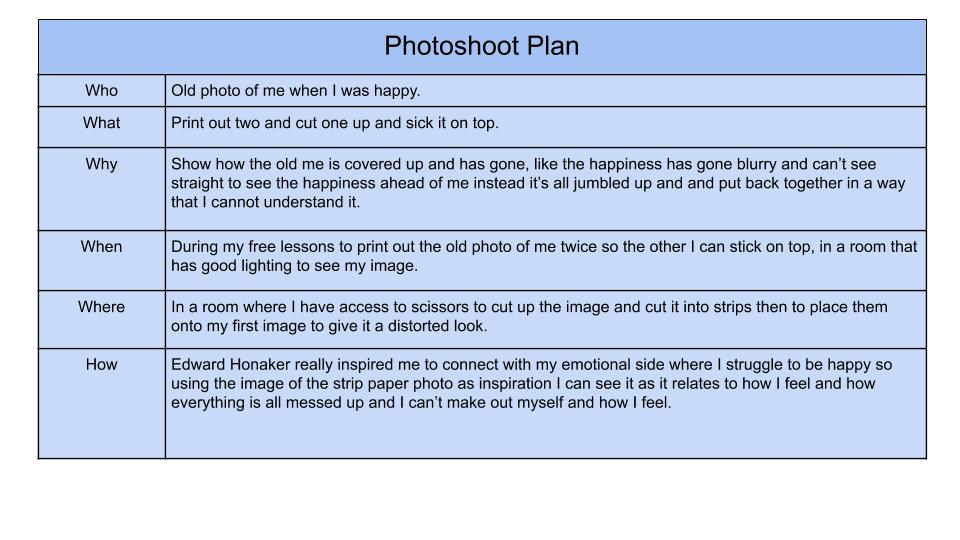
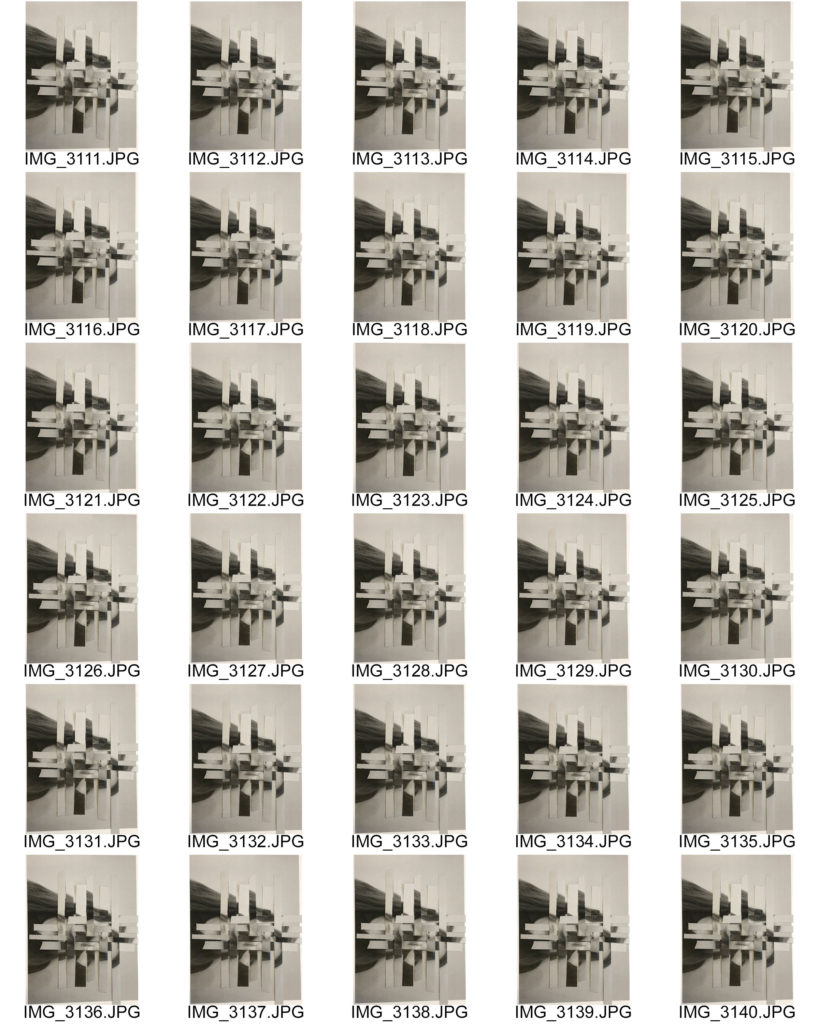
Final outcome

The use of jagged cut paper show the distress of photo, how the slips of paper are cut in different lengths and with slanted cuts which make it look messy and random which reflects how I feel in my head, messy and chaotic with no set path of directions. This links back to the photographer because h puts the strips of paper on his head to show how this links to his depression and anxiety which students tend to have when facing their exams especially with corona messing up their learning. I find that with corona messing up my learning so I find that I’m struggling, that links to the photographer because his images resemble the struggle that people have to go through whether they have mental health problems or not.
Self Image
CONTROLLED CONDITIONS
Psychological identity relates to self-image and how you see yourself in your own eyes. Your self image influences you identity quite a lot because depending on how you see yourself helps other peoples opinions on you come from.
I chose this photographer to resemble my self image because I tend to find myself quite two faced towards people like how I wear a mask to hide my true personality from people and show them only what I want them to see from me. Throughout my life my personality has changed and how my self image has changed my identity, my personality has changed in ways that it has pushed people away and brought people closer to me so I find I mostly struggle with my self image as I still don’t understand who I am so trying on different faces helps me connect on who I want to be and who I find I truly am.
Mood Board
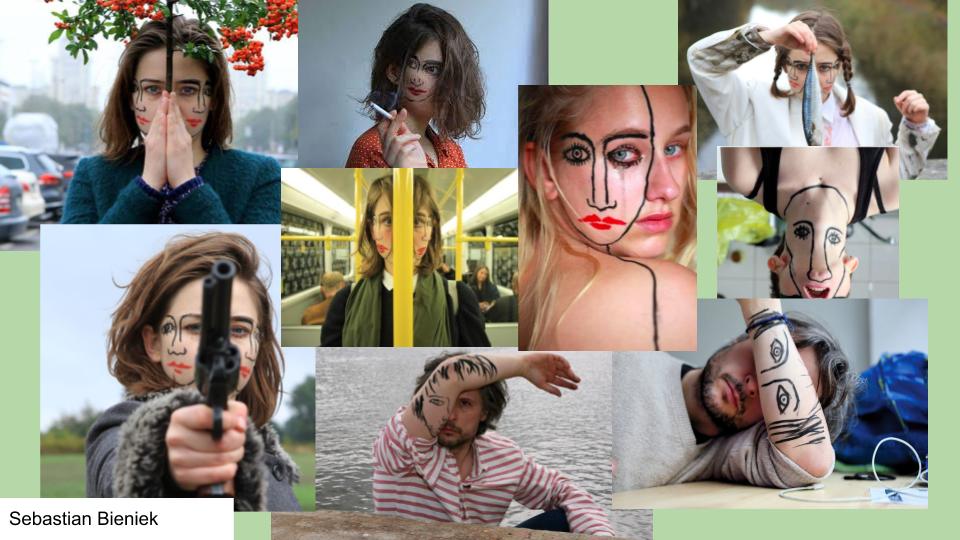

Mindmap

Case Study
Sebastian Bieniek
In 1999 Sebastian Bieniek for the very first time known in TV and magazines due to the performance “Hand without a body”, he also became part of film history with his film “The Gamblers” in 2007 because there was never before a movie made with such a small budget of 2000€. In 2011 Bieniek wrote the book REALFAKE where he described the theoretic fundament of his following artworks. The performance “My Friend Dr. Winker von der Deutschen Bank” in 2013 was widely published on the media causing a new phase of his work as an artist. Bieniek continued to work on his Manualism works in 2014. He travelled the world and began the “No Matter World Tour” where there perform in public spaces in different cities and countries.
His work of “Doubledfaced” shows a story of a two faced woman going about her day doing daily tasks such as drinking coffee, traveling on the train, taking a shower, and smoking cigarettes. he does this by using an eyeliner pencil and a lipstick to draw another face onto the woman and using her hair to cover her mouth and nose using one of her real eyes as part of the fake face, he then took 22 photos of this woman throughout her day.
Claude Cahun
Claude Cahun’s work is unexplainable as it changes the way she looks in all her photos changing from male to female defining gender to how we know and understand it. In her writings she wrote “Masculine? Feminine? But it depends on the situation. Neuter is the only gender that always suits me”, and “I will never finish removing all these masks”
Photo Shoot



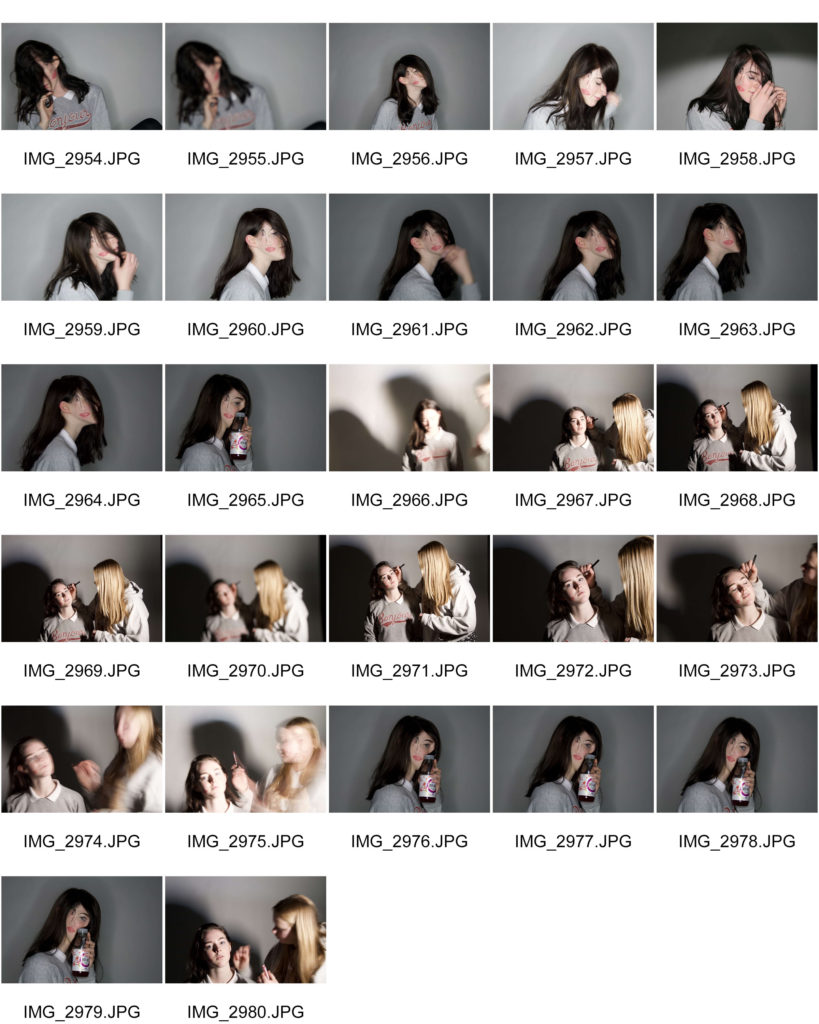
Final outcome
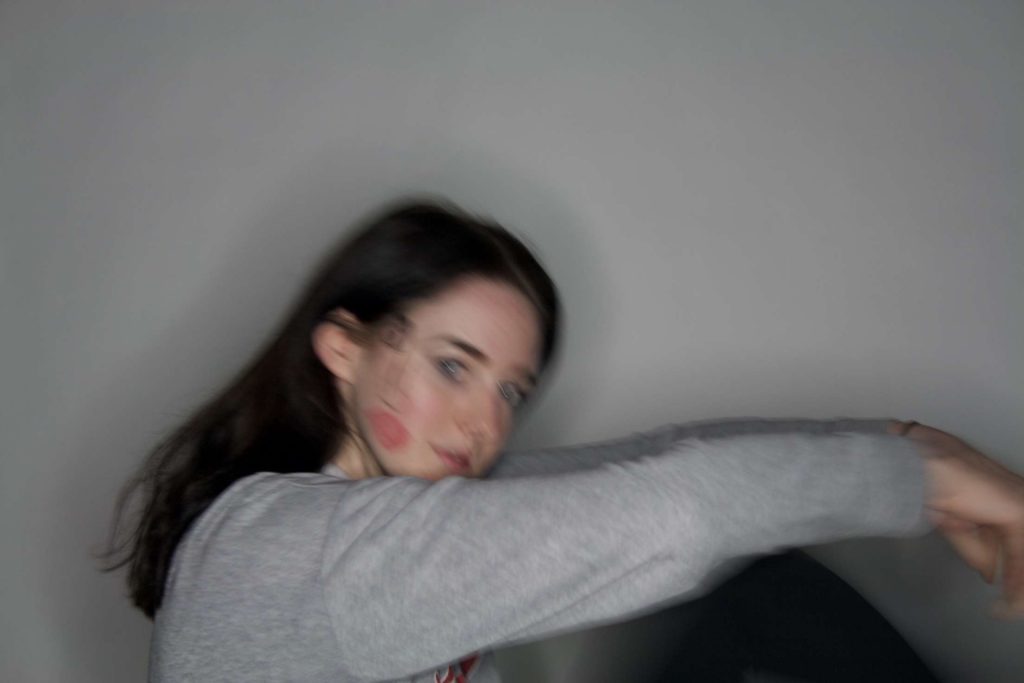
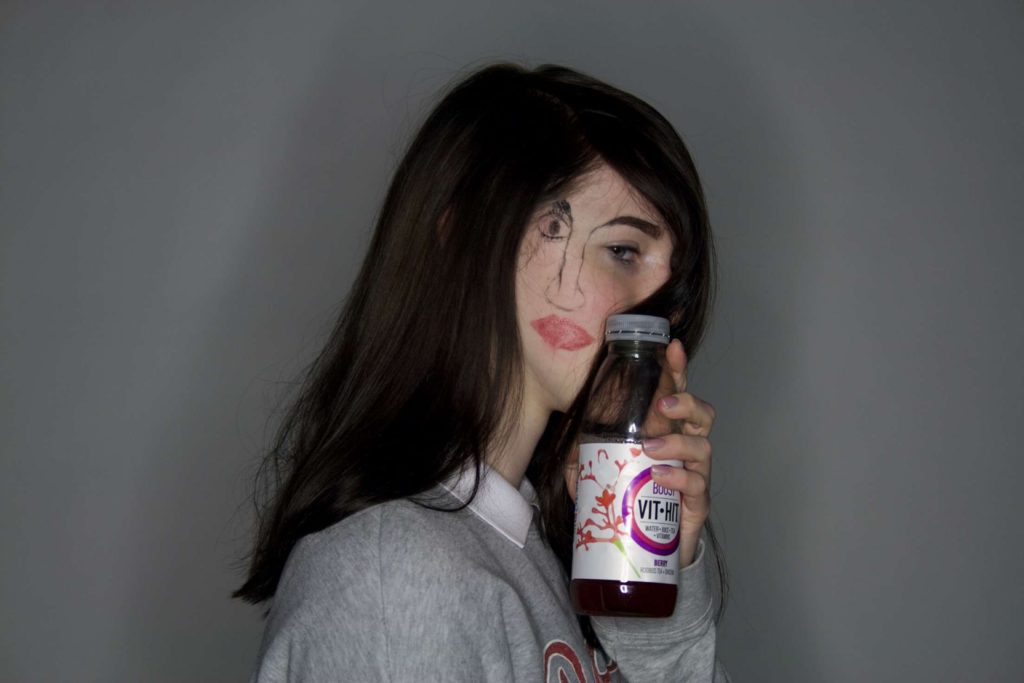
I chose these images as my final outcome because the first one is blurry which shows how everything isn’t perfect and can’t be picture perfect. I slowed down the shutter speed to give the burry affect to the image which gives it the impression that it’s not perfect. The tones of this image that I created is cold giving a feeling of unhappiness with the fake face created, this reflects my personality because I find that when I become this new person I become very cold towards people and unloving which contrasts my true personality.
The second photo I chose because it uses one of my daily tasks of drinking my favourite drink yet it doesn’t completely link to the photographer as he takes photos of the woman during her daily activities as though it is natural for her to sit there with another face drawn on her face, I could improve this work by taking photos of me doing my daily tasks instead of the studio which I was to do this again I would go outside and sit where I usually wait to meet my friends or sit in my favourite coffee shop or sat in the library doing my homework.
Both these photos represent the photographer with the other face drawn on my own face yet it doesn’t completely match as there is room for improvement towards my photo shoot with placing and how the face is drawn on my own face as I find that it was too far away from my eye. They also link to the photographer with the idea of having another face on your own face and hiding the original face such as the nose and mouth.
Hobbies
CONTROLLED CONDITIONS
I’ve danced for as long as I remember, it became a part of me, going home after school to then have a snack then into my dance kit ready for dance where my mum would drop me off. When I got older I would walk to the dance studio with my friends after school and sit there stretching and get ready together for our dance lesson as we were so keen and excided to learn a new dance but then I moved away and I lost that connection with my friends, I lost part of my passion when I left.
Mood Board

Mindmap

Case Study
Darian Volkova
Darian Volkova is know well in the ballet world, she is a a Russian ballet photographer, ex-ballerina and a continuous explorer of the unique field of ballet photography. With her good knowledge of ballet she uses this to this to get the people she takes the photos of to get the dancer to use certain lines of choreography to get excellent photos with beautiful dynamics in the images. She teaches people how to make the best ballet photo and how much work goes into placing ballerina’s body into the proper pose for the best possible ballet photograph. Darian describes herself as a “ballet maniac”, knowing just how to show off a ballerina’s talent through her photos. She followed her childhood dream of becoming a ballerina but also becoming a ballet photographer, and an international ballet spokesperson, bringing her passion to the 160K+ followers of her feed.
As both a photographer and ballet dancer, Darian’s collection gives us an intimate insight into the beautiful art of ballet. Often set in the inspiring atmosphere of Russia’s Saint Petersburg Ballet Theatre, her images capture the stunning movement and graceful lines of her dance troupe. Darian also studies the history of ballet photography, gives lectures, and runs workshops for aspiring ballet photographers.
Photo Shoot




Final outcome
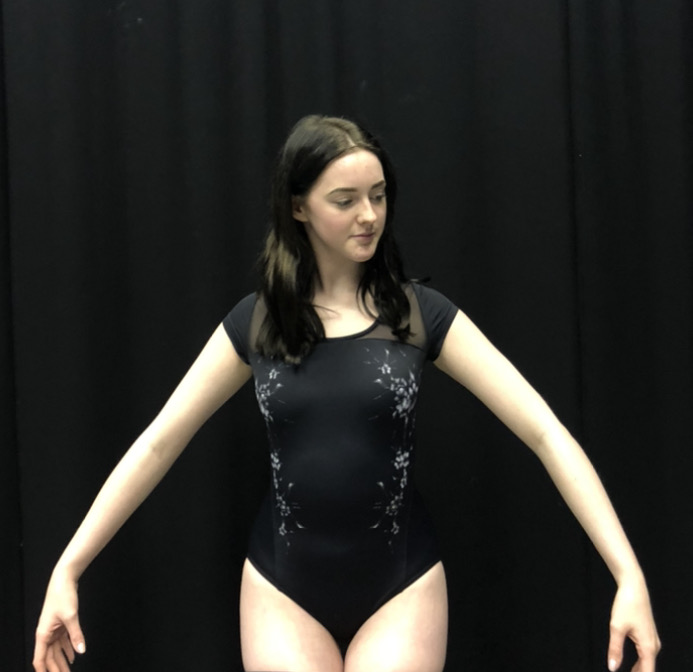
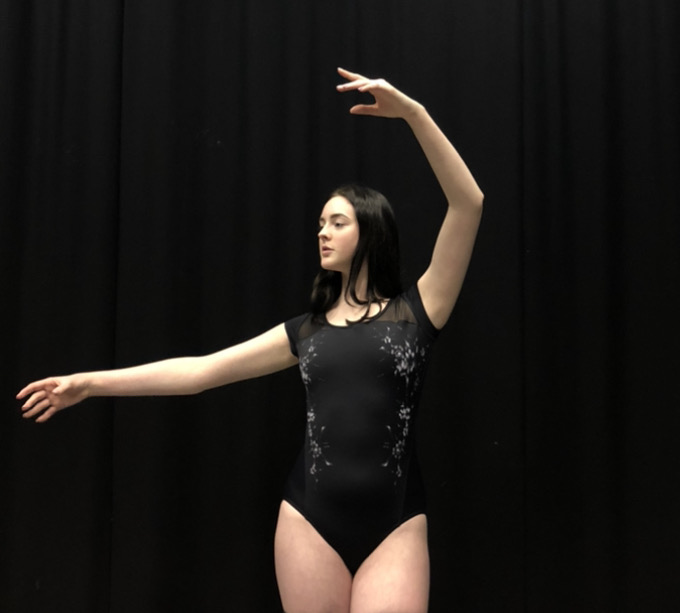
With this image I wanted something that is low and shows how I started small then grew to be a stronger and more improved dancer. I wanted to focus the photos on my arms as they emphasis my dancing ability and I also wanted to use simple dance movements from the photographer as I feel they’re simpler yet more effective in my photos.
In this photo i’m in a more up right position to show the growth in my dance and how I’ve improved so much and how my confidence in my dance has improved so much since when I first started when I was younger. It also emphasises the smaller movements yet it still shows how small things can make a difference which is true to dance.
